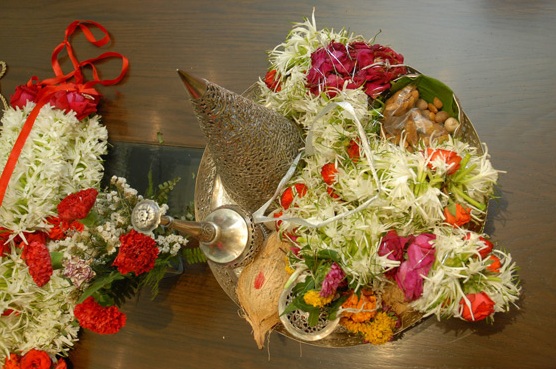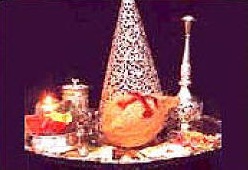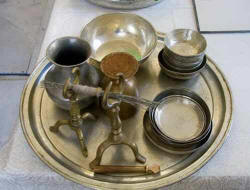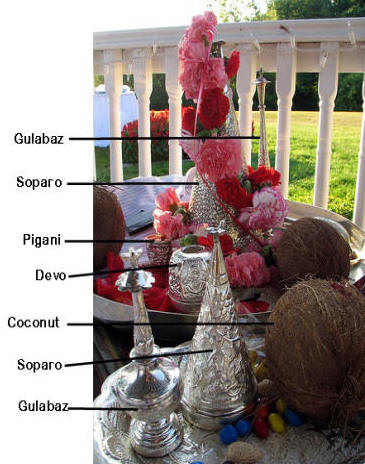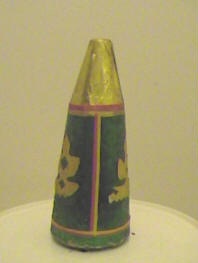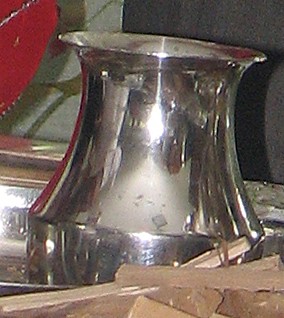
| SACE / SES
Sace Description & Purpose :
A sace (or sas) A sace or ses is a tray that holds various ceremonial utensils and items that will be used during a Zoroastrian ceremony or that have symbolic importance. The utensils and items placed on the sace will depend on the occasion.
Priestly ceremonial utensils The utensils employed by the laity and by priests are different. The sace and the items used by the laity are usually smaller and more delicate while the ceremonial implements employed by priests are more sturdy and functional. We will describe the sace used by the laity in this page.
Use
:
The Zoroastrians of Iran may however, employ a simple version of the sace similar to the priestly ceremonial tray shown above left. The tray may contain some of the following: an afarganyu or afargani - a portable an urn or censer for a wood fire, perhaps some wood and incense for the fire, a rose-water holder, mirror, a cone of sugar, a pomegranate and any other items the user may wish to add. Iranian Zoroastrians often place all the articles and items used in a ceremony on a sheet spread (sofreh) on the floor or on a table.
For the Zoroastrians from India, the sace is an integral part of the navjote (initiation), jashan (thanksgiving) and marriage ceremonies as well as the achu michu ritual that is often a part of these ceremonies. It is also used for a variant of the jashan ceremony when welcoming a special guest to one's home or if a newborn enters a family member's house for the first time. The sace is also used during festivals such as Nowruz, when it is placed on the Nowruz table.
When not being used ceremonially, a sace is sometimes used to form a home altar.
Construction :
The accessories are placed on the tray. The sace and its accessories can be plain in design or can be exquisitely crafted often forming part of a family heirloom.
Symbolism - Amesha Spentas :
The
seven elements are represented as follows :
Components & Accessories :
A sace and its components The components and accessories can include :
• Sace - the high rimmed circular metal tray large enough
to hold the accessories and ritual items.
•
Devo or oil lamp.
In a post on the internet, Shirin J. Mistry (Shirinmai) remarked, "...we dip sugar lumps... into curds and then place into the mouth of the ones being welcomed in (a home or to a ceremony). If a baby visiting your home for the first time, then the Mum gets to eat the goodies."
Green covered ghand / sugarloaf
• The soparo may be a development of the Iranian Kaleh Ghand,
a cone of sugar loaf (or maybe even rock sugar) wrapped in foil.
Rather than being a ritual item on a tray, the Ghand is sometimes
given to a person or persons who are the object of a ceremony. The
colour of the foil is either green, or green and gold. A farohar
motif is sometimes added.
If the sace is used for the achu michu ritual, the accessories are usually containers for the items that will be used in the ritual. Once again, the items vary widely depending on the preferences of the person performing the ritual, the availability of the items, the size of the tray and the weight of the ensemble - since the tray is carried, often by an assistant. If no assistant is available, the tray and its contents are placed on a table beside the person performing the ritual.
Kutli Items :
Depending on the occasion and the symbolism desired, the items on the tray and their containers (usually metal, sometimes glass) can include :
•
Wood : any bone dry wood that burns well without
excessive smoke. Sandalwood, called sukhar, was the traditional
wood used by Indian Zoroastrians. In Central Asia, Juniper and Plane
(Chenar) wood are options. Also see our page on Fire.
Patasa (Batasha) • Other forms of sugar: candy or the traditional patasa (also spelt batasa or batasha) - sugar rounds. (see recipe below.)
(Patasa
are not to be confused with a biscuit/cookie popular with Indian
Parsi and Irani Zoroastrians. Indian Zoroastrian distinguish between
the two by calling the sugar round a patasa and the biscuit a batasa.
Click for a batasa biscuit recipe.)
Paan leaves and split supari (inset-right)
• Betel nut or supari. (symbolizing
strength) [The betel nut is the fruit of a tall and slender palm,
Areca catechu Linnaeus, native to southeast Asia. The betel nut
is a stimulant like coffee, and the stimulant compound the nut contains
is arecoline, an alkaloid. Powdered betel nut administered in a
syrup is a recognized treatment to rid the intestines of tape worms.
Regular chewing of the betel nut is a known cause of oral cancer.
The use of the betel nut and leaf in Zoroastrian rituals are entirely
borrowed from Indian customs and are not part of Iranian or Central
Asian traditions.]
Patasa
Recipe :
Method
:
Source :
http://www.heritageinstitute.com/ |
